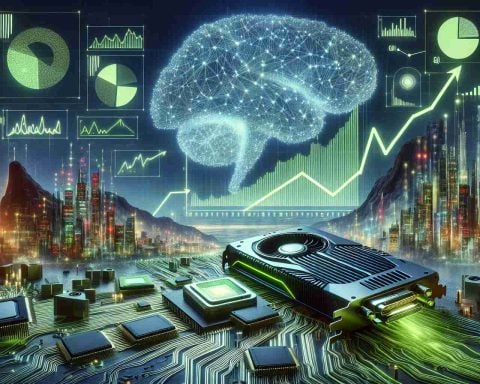- The rapid expansion of AI-powered data centers is causing a substantial rise in global electricity demands.
- This surge in energy consumption demands a reevaluation of green energy strategies, impacting technologies aimed at combating climate change.
- Direct air capture (DAC) technology is particularly affected, competing for low-carbon electricity with AI infrastructures.
- The increased demand for renewable energy is leading to higher costs, creating uncertainty for carbon capture initiatives.
- Businesses relying on carbon credits are facing higher operational expenses due to rising electricity costs.
- Balancing AI development with sustainable energy advancements is crucial to achieving a harmonious and green future.
Amidst the swift rise of artificial intelligence, a quieter but equally powerful force surges beneath the surface—soaring electricity demands. As AI-powered data centers mushroom across the globe, their voracious energy appetites force a reevaluation of our green energy strategies, triggering unexpected ramifications on technologies meant to combat climate change.
The race to harness renewable resources intensifies under the shadow of AI’s rapid expansion. Imagine the bustling corridors of these digital giants, buzzing with the relentless hum of servers processing vast streams of data. This digital hunger, however, sends shockwaves through the energy landscape, threatening to eclipse the development of pivotal carbon-neutral technologies.
Direct air capture (DAC), a cutting-edge technique designed to snatch carbon dioxide directly from the atmosphere, finds itself in a precarious position. Envision sprawling arrays of whirring machinery, each struggling to fulfill its promise of reducing atmospheric CO2. Yet, they’re tethered to the same supply of low-carbon electricity now coveted by AI infrastructures, pushing the costs—and the stakes—higher.
With the cost of renewable energy soaring, fueled by demands from burgeoning data centers, the future of carbon capture hangs in uncertainty. Businesses that hinge on selling carbon credits are feeling the pinch, as they grapple with inflated operational expenses.
In a world where AI and ecology are entwined in an intricate dance, the balance of power is delicate. As society hurtles towards an AI-driven future, we must not overlook the emergent challenge: harmonizing our digital ambitions with sustainable energy progress. Addressing this conundrum is vital if we are to secure a truly green future, where technology and environment flourish side by side.
The Hidden Cost of AI: How Soaring Energy Demands Are Shaping Our Green Future
The rapid expansion of artificial intelligence (AI) technology has ushered in a new era of innovation, while simultaneously imposing unprecedented demands on global energy resources. As AI-powered data centers proliferate globally, their substantial energy consumption necessitates a reevaluation of our green energy strategies. This development holds significant implications for technology, environment, and policy, compelling us to scrutinize the landscape of AI and sustainability.
Key Considerations and Implications
1. Increased Energy Consumption by AI:
AI systems, particularly in large-scale applications such as machine learning and neural networks, require enormous computational power. Data centers, which are the backbone of AI technologies, consume vast amounts of electricity to operate effectively. According to a report by the International Energy Agency (IEA), data centers contribute to about 1% of global electricity demand, and this is expected to rise with AI integration.
2. Intersecting Challenges with Renewable Energy:
The growing demand for energy from AI data centers competes directly with the needs of renewable energy infrastructures. Technologies like Direct Air Capture (DAC), crucial for mitigating climate change by capturing atmospheric CO2, rely on low-carbon electricity. The shared demand could strain the availability of renewable resources, driving up prices and potentially stalling DAC installations.
3. Impact on Carbon Credits and Eco-friendly Innovations:
High operational costs, driven by competitive energy consumption, could affect businesses depending on carbon credits. Small firms and startups that innovate in carbon-neutral technologies may find it economically challenging to sustain or scale their operations, threatening the pace of ecological advancements.
4. The AI Industry’s Responsibility Towards Sustainability:
AI firms, along with tech giants, hold a responsibility to adopt more energy-efficient technologies and practices. Advancements in emerging technologies such as quantum computing could usher in transformative changes by reducing computational energy needs. Initiatives like Google’s “carbon-aware computing” aim to schedule energy-intensive tasks when low-carbon energy sources are abundant.
Addressing the Conundrum
A Balanced Approach:
Strategizing a balanced approach between advancing AI and promoting renewable energy is essential. Policymakers, industry leaders, and environmentalists must collaborate to design integrated solutions that support the logical growth of AI while ensuring sustainable energy consumption:
– Investment in Energy Efficiency: Encouraging investments in energy-efficient technologies for data centers can alleviate energy pressures. Cooling systems, server optimization, and embracing low-energy AI algorithms can significantly reduce consumption.
– Enhanced Renewable Energy Infrastructure: Expanding investment in renewable energy infrastructure and smart grids can support the growing energy demand without undermining carbon-neutral initiatives. Research into alternative renewable sources and storage solutions is also crucial.
– Policy Frameworks: Developing policies that incentivize the use of renewable energy and impose limits on energy consumption can help balance ecological needs and technological growth. Carbon pricing and regulatory measures should focus on sustainable growth.
Conclusion
The intersection of AI growth and energy demands presents both challenges and opportunities. As we traverse this complex landscape, a commitment to innovative solutions and sustainability will be key to harmonizing the digital realm with environmental priorities. This equilibrium is vital if we are to secure a green future where technology and the environment can prosper together.
For more information on AI and sustainability initiatives, you can visit the International Energy Agency and the Intergovernmental Panel on Climate Change.




















